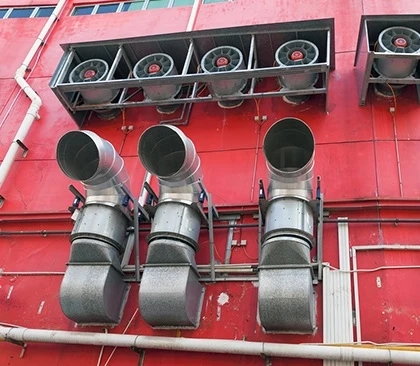In the bustling realm of culinary delights, where flavors meld and aromas enchant, lies a vital yet often overlooked component: the kitchen exhaust system. Imagine stepping into a busy restaurant – the sizzle of ingredients, the clinking of utensils – a symphony of culinary artistry. However, amidst this orchestration of taste and texture, there's a silent hero working diligently to maintain the harmony between gastronomy and safety – the kitchen exhaust system.
Kitchen Exhaust System: The Unsung Guardian of Clean Air
Restaurants, hotels, and commercial kitchens are the beating heart of the food industry, where delectable dishes are born and appetites are satiated. Behind the scenes, though, the process can get rather steamy – quite literally. The kitchen is a realm where culinary magic is conjured, often resulting in the production of smoke, grease, and odors that can infiltrate every nook and cranny if left unchecked.
This is where the kitchen exhaust system emerges as an unsung hero. It acts as a stalwart guardian, ensuring that the air within the kitchen remains breathable and safe. By swiftly removing smoke, grease particles, and airborne contaminants, the exhaust system maintains not only the cleanliness of the kitchen but also the safety of the chefs and staff working tirelessly to create memorable dining experiences.
The Mechanics of a Kitchen Exhaust System
At its core, a kitchen exhaust system is a complex network of components working in harmony to maintain a pristine environment. The system includes an exhaust hood, which is strategically positioned above cooking equipment, and a series of ducts that transport the unwanted byproducts away from the kitchen. The heart of the system is the exhaust fan, which provides the necessary suction to pull the contaminants through the ductwork and expel them outside.
To ensure the efficiency of the system, regular maintenance is crucial. Grease buildup within the ducts can pose a significant fire hazard, making periodic cleaning a non-negotiable task. Additionally, the exhaust fan's performance should be monitored to ensure it's providing adequate suction power. Neglecting these maintenance aspects could lead to compromised air quality, increased energy consumption, and heightened safety risks.
Benefits Beyond Clean Air
While the primary function of a kitchen exhaust system is to maintain air quality, its benefits extend far beyond the realm of cleanliness. A well-designed and properly functioning exhaust system contributes to a healthier work environment. Chefs and kitchen staff are exposed to high temperatures and potentially harmful fumes, but a reliable exhaust system minimizes these risks, creating a safer and more comfortable space to work in.
Furthermore, an efficient exhaust system can also lead to cost savings. By expelling hot air and smoke, the system helps regulate the temperature within the kitchen. This reduces the strain on cooling systems and, in turn, lowers energy consumption. The removal of grease and contaminants also prevents potential damage to kitchen equipment, leading to longer lifespans and fewer repair or replacement costs.
Innovations in Kitchen Exhaust Systems
As technology continues to advance, kitchen exhaust systems have evolved beyond their traditional roles. Modern systems incorporate smart sensors that can detect changes in air quality and adjust the fan speed accordingly. This not only enhances energy efficiency but also ensures that the system operates optimally at all times.
Furthermore, noise reduction has become a focal point in the design of exhaust systems. The clatter of a loud fan can disrupt the ambiance of a dining space, so manufacturers are investing in quieter fan designs that maintain the delicate balance between functionality and aesthetics.
A Clean Sweep for Safety and Efficiency
In the grand tapestry of culinary excellence, the importance of a well-maintained kitchen exhaust system cannot be overstated. It's the silent force that sweeps away the remnants of culinary creativity – the smoke, the grease, and the odors – leaving behind a safe and clean environment for chefs to weave their gastronomic wonders.
From its humble beginnings as a mere mechanism to expel unwanted byproducts, the kitchen exhaust system has risen to become a pillar of safety, efficiency, and innovation in the culinary world. Its unobtrusive presence is a testament to its effectiveness, silently upholding the standards of cleanliness and well-being that every food establishment should strive for.
So, the next time you step into a bustling restaurant, take a moment to appreciate the quiet guardian above the stoves – the kitchen exhaust system – tirelessly ensuring that every bite you take is not only flavorful but also prepared in an environment that prioritizes your health and satisfaction.
In a world where flavors dance and aromas enrapture, let's not forget to give credit to the unsung hero that lets the culinary show go on: the indispensable kitchen exhaust system.


